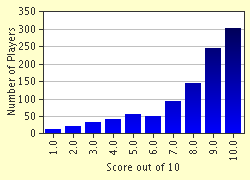Quiz Answer Key and Fun Facts
1. A right triangle ABC is given where angle B = 90 degrees.
Which side of the triangle is the longest?
2. There is a right triangle PQR where:
angle Q = 90 degrees;
angle P = angle R.
What is the measure of angles P and R?
3. The Pythagorean Theorem states that:
"The square of the hypotenuse of a right angle triangle is equal to the sum of the squares of the other two sides."
This means that, in a right triangle ABC with hypotenuse AC:
4. A right triangle LMN is given where:
side MN = 4
side NL (the hypotenuse) = 5
What is the length of side LM?
5. Two right triangles are congruent if the hypotenuse and one side of triangle are congruent to the hypotenuse and the corresponding side of the other triangle respectively.
6. Out of the following triangles, which is *NOT* a right triangle?
7. If there is a square whose diagonals are of length 2^(1/2) (i.e. the 'square root of two'), what is the length of each side of the square?
8. There is a triangle XYZ where XY is perpendicular to YZ and angle X = 70 degrees. What is the measure of angle Z?
9. In a right triangle, the sum of the lengths of the two sides (not the hypotenuse) is *ALWAYS* greater than the length of the hypotenuse.
10. A right triangle, ABC, is given, where angle B = 90 degrees. The side AB is extended past angle B to form an exterior angle, X. What is the measure in degrees of angle X?
Source: Author
achernar
This quiz was reviewed by FunTrivia editor
CellarDoor before going online.
Any errors found in FunTrivia content are routinely corrected through our feedback system.

